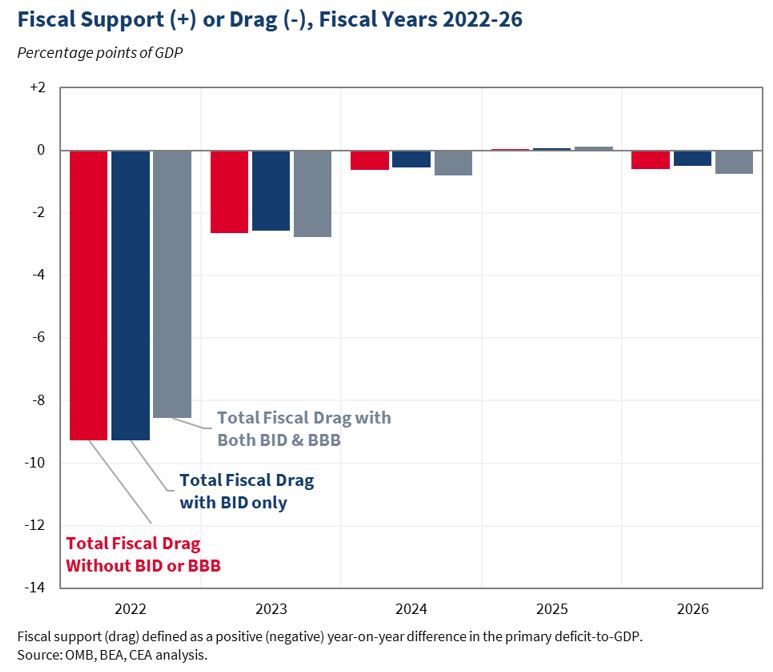An Update on Fiscal Drag
By Jared Bernstein
In August, CEA wrote a blog post outlining the economics behind President Biden’s statement that “if your primary concern right now is inflation, you should be even more enthusiastic about this plan,” referring to the infrastructure and Build Back Better agendas.
Now that the Bipartisan Infrastructure Deal (Infrastructure Investment and Jobs Act) has passed Congress and the Build Back Better Act (BBB) is getting closer to enactment, I wanted to update a few of our observations, which again demonstrate how they support the President’s initial assertion. While the Biden administration is hard at work to address the current supply-chain bottlenecks that contributed to this month’s elevated inflation report, the effects of the packages—low short-run fiscal impulse, strong long-run supply enhancement—are designed to avoid such constraints in the future.
Because the fiscal support from the American Rescue Plan (ARP) is now fading, CEA’s earlier post noted that fiscal impulse—the impact of yearly changes in government spending on the economy—was about to flip from a strong positive to a strong negative. This is characteristic of any temporary relief or countercyclical measure: if well-designed, it gets into the economy quickly, helps offset the shock that is hurting economic growth, and fades once its work is done. There is considerable evidence, both in terms of health and economic outcomes, that the ARP fits this description.
But as the ARP support fades, the figure below shows that next year, its fiscal drag amounts to about 9 percentage points of GDP without taking into account the Bipartisan Infrastructure Deal (BID) and BBB. But what impact will the BID and BBB have on fiscal impulse in general and on inflation in particular?
If the ARP was like a fast-acting medicine for the economy, BID and BBB are more like time-release capsules that make the economy healthier over time. Starting in 2022, the BID has no visible impact at all on fiscal drag (see second bar in the figure below). While planning for BID-financed, job-creating projects are likely already underway, infrastructure spending occurs at a slower cadence than relief spending. CEA’s analysis of the score by the Congressional Budget Office (CBO) suggests that its gross spending amounts to $16 billion in 2022, the first year it will be in effect. That is the equivalent of 0.06 percent of GDP, less than one-tenth of 1 percent. And, the CBO finds that the BID’s “pay-fors” offset $18 billion in 2022, meaning that in 2022, the BID is actually a slight net deficit reducer—the relevant metric when thinking about inflationary pressure. In its second year (2023), BID gross spending ramps up slightly to $38 billion, or 0.15 percent of GDP, for a deficit effect of $9 billion.

Meanwhile, the BBB offsets a bit more of the ARP’s fiscal drag than the BID in 2022; but, most of BBB’s 2022 fiscal impulse stems from extensions of programs newly introduced in 2021: the Earned Income Tax Credit for childless adults and the expanded Child Tax Credit. So, relative to where we are now already, these provisions are not elevating price pressures.
Taken together, these dynamics create no obvious quantitative case for exacerbating inflation. Their magnitudes are too small to significantly boost demand in the short term, and they offset little of the fading ARP’s fiscal drag. Once enacted, BBB will continue to help vulnerable families with children rise out of poverty, and from the perspective of inflation, many of its effects are already “baked into” current price levels. Simply put, the two bills are occurring in a period of historically large fiscal drag that will dampen inflationary pressures, and their fiscal impact does not substantially change that story.
The President’s assertion also stems from the fact that both the BID and BBB make fulsome contributions to the economy’s capacity, which, as 17 Nobel economists recognized, are designed to ease inflationary pressures. In the end, whereas the ARP was a short-term emergency relief package, the BID and BBB are long-term investments that need to be analyzed differently. Their short-run price pressures are unlikely to be significant, and as they ramp up over time, they will gradually increase the potential of the economy and reduce inflationary pressures.

